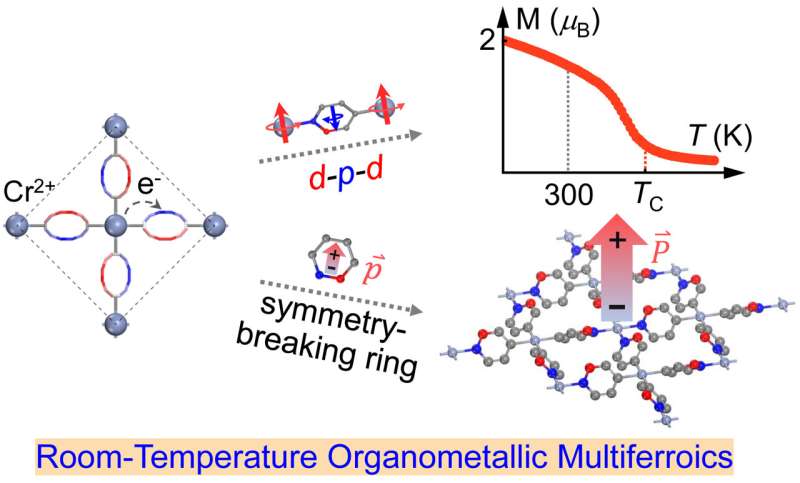This article has been reviewed according to Science X's editorial process and policies. Editors have highlighted the following attributes while ensuring the content's credibility:
fact-checked
peer-reviewed publication
trusted source
proofread
Scientists propose theoretical design strategy for room-temperature metal-organic multiferroics

A research group led by Prof. Li Xiangyang from the Hefei Institutes of Physical Science of the Chinese Academy of Sciences has theoretically predicted a series of multiferroic materials that can be applied in room-temperature environments by utilizing the d-p spin coupling combined with center-symmetry-breaking organic heterocycles in two-dimensional (2D) Cr-based metal-organic frameworks.
The results are published in Nano Letters.
Multiferroic materials, characterized by the coexistence of two or three ferroic orders, have emerged as a key research platform, driving advances in information storage, sensing technologies, electronics, and energy conversion. The advent of 2D materials has revitalized the field of multiferroics, promising thinner, more efficient, and versatile functionalities. However, despite significant progress in the field, the number of 2D multiferroics with room temperature magnetism is still notably low.
To overcome this challenge, the researchers proposed a novel approach to achieve 2D room-temperature multiferroics in 2D metal-organic frameworks (MOFs) by exploiting the d-p spin coupling in combination with center-symmetry-breaking six-membered heterocyclic ligands.
Using this method, they investigated 128 different 2D MOFs and discovered three unique multiferroic materials: Cr(1,2-oxazine)2, Cr(1,2,4-triazine)2, and Cr(1,2,3,4-trazine)2. All of these materials exhibit both ferrimagnetism and ferro/antiferroelectricity at room temperature. The room temperature ferrimagnetic order is thought to arise from the strong d-p direct spin coupling between Cr cations and ligand anions.
Specifically, Cr(1,2-oxazine)2 exhibits ferroelectric properties, while the latter two exhibit antiferroelectric properties. Impressively, each of these materials possesses suitable barriers for polarization switching.
"Our study provides a promising platform for the design of 2D room-temperature multiferroic materials," said Prof. Li Xiangyang.
More information: Qingqing Feng et al, A Route to Two-Dimensional Room-Temperature Organometallic Multiferroics: The Marriage of d–p Spin Coupling and Structural Inversion Symmetry Breaking, Nano Letters (2024). DOI: 10.1021/acs.nanolett.4c00210
Journal information: Nano Letters
Provided by Chinese Academy of Sciences



















